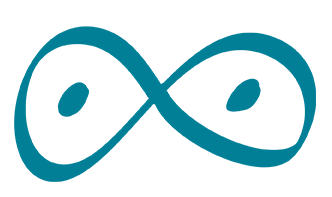
Creative Tensions are natural features of collaboration. They appear anytime people try to work together—and the more complex and difficult the challenges, the more powerfully they show up.
These tensions (often called “polarities”) are comprised of two values that seem to be in opposition but are actually both needed in order for a group to be successful in its work. They are held in tension by our need for both values--hence the infinity loop pattern. Take Action & Analysis for example: You’ve probably seen how dysfunctional a group can be if it consistently rushes to action without doing any analysis. And I'm sure that you're also familiar with groups that get stuck in analysis and seem unable to move into concrete action.
But the tensions that many of us worry about and attribute to bad behavior (and often try to manage around) can also be sources of deep understanding and profound innovation. By framing them as positive assets and helping people see that they really want the best of both side of the tension, we can help our networks collaborate more deeply and design better, more resilient solutions.
One way we do this at CoCreative is to name the tensions that are likely to show in a work session at the very outset of the session. By naming tensions like these right up front (just like we do with agreements or groundrules), we help the group leverage them more effectively during the meeting itself.
Here are tensions we commonly name as part of the context for any work session, along with some sample language you might use:
Fast & Slow. “There will be times when we’re moving really fast and other times when things will seem slow. Depending on your own personal preferences, you could be frustrated at times so just understand that we need to do both over time to be successful in our work together.”
Going Broad & Going Deep. “To really understand the nature of the challenge we’re working on together, we’ll need to get a broad view of the landscape we’re working it AND dive deep into parts of that landscape at times."
Tight & Loose. “At times, I’m going to facilitate pretty tightly to keep things moving at a good pace and at other times in our work together, we’ll have more open exploration and discussion.”
Long-term & Short-term. “We need to advance both quick wins to build momentum and buy-in AND focus on our long-term systems change strategy. Clearly, doing one of these to the neglect of the other would undermine our effectiveness. So if at times, we seem to be focusing on one and not adequately addressing the other, just note that and flag us if you think that’s becoming a pattern.”
Introvert & Extravert. “You all may be familiar with this dynamic. Some people need time to digest, reenergize, and reflect before speaking while others shape their thinking as they talk. Often in meetings, the extraverts win because they talk the most, so at times we’re going to take a few minutes to allow preparation and reflection before we start a discussion or analysis. That way, we’ll get the best thinking from everyone.”
Data-driven & Intuitive. “Some people like to work intuitively and others like to rely on data-driven analysis. We’re going to do both in our work together because there are strong benefits to each way of working.”
Learning & Doing. “We’re doing what some people call ‘action learning’ and at times we’ll be working on specific ideas and solutions and other times, we’ll be learning more deeply about something we need to understand to advance our work.”
Doing work & Deepening relationships. “While we all know that we’re here to get real work done on this issue, there is a large body of research that shows that the quality of ‘relational trust’ in a group is a primary determinant of success. So we’re going to do things in our work together that are designed to both advance the work and to deepen our relationships so we work more and more effectively over time.”
Using Design Tensions as context for a work session is just one of the ways we use them in our work. Let us know if you’d like to learn more about this important and valuable skill that can really power a group past stuckness and polarization.
To learn more about leverage these tensions, check out the Polarity Thinking approach developed and taught by Dr. Barry Johnson and his colleagues at Polarity Partnerships.
For more details on of each of the 6 Patterns in Collaboration, see below.

.png)